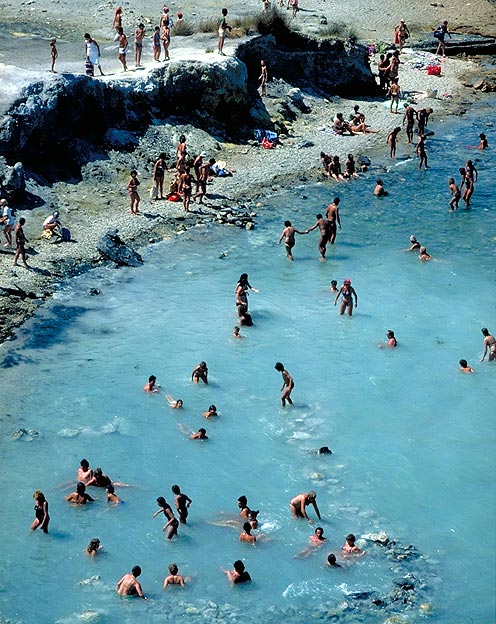Vulcano: Fumaroles, Crater Lake and FlowersPhotos Jürg Alean (JA) and Marco Fulle (MF). |
 Fish-eye view of Vulcano (center) and Lipari's "faraglioni" Pietralunga and Pietra Menalda (bottom right) from Lipari's Monte Falcone (MF). |  On clear day all Eolian Islands are visible: from left to right: Alicudi, Filicudi, Salina (prominent double volcano behind Lipari), Lipari, Panarea, Stromboli. (MF). |  Vulcano's largest field of fumaroles is along and inside the crater's northern rim. Note small ephemeral lake after heavy winter rains at the bottom of the crater (MF). |  Jürg and his setup for panorama photos within the fumarole field. Alicudi (left), Filicudi (above head) and Salina (far right) in the background (MF). |
 The path leading up from the Vulcano Porto village (visible in the background and in front of the Vulcanello complex) to the crater rim traverses partially consolidated deposits of red volcanic ash (JA). |  While to uppermost slopes may appear barren in summer, a climb in spring reveals bushes of Cistus salvifolius (white) and some Cistus creticus (pink) (JA). |  The twin peaks of Salina and the complex topography of Lipari appear above a small valley formed by an outer and inner crater rim of Vulcano's Fossa crater (JA). |  Submarine fumaroles heat the seawater near Vulcano Porto. Precipitated molecular sulfur particles cause the water's pale blue colour (JA). |
 Taking a close look at the fumarole field and a nose full of its sulfurous gases inside the Fossa crater (MF). |  Marco at the same location as in the image on the left, now seen from the shore of the ephemeral crater lake (JA). |  The rains have washed tiny pumice pebbles (white) and innumerable rabbit droppings (black) into the lake. A fumarole bubbles on the bottom (JA). |  Evening falls over an unusual, lonely beach: Vulcano's crater lake will be gone in a few days and with it a memorable view on cold but sunny February day (JA). |
 Vulcanello in 1923. It emerged in 183 or 123 BC as a new island. Sporadic eruptions continued until the mid 16th century AD. By then the new island had enlarged and connected with the main island of Vulcano. |  Vulcanello as seen in 1972. Note that now the small volcano's shield is partially covered by vegetation, mainly eucalyptus trees meant to provide shade for the starting tourist infrastructure (JA). |  Vulcanello in 2003: Note the massive developments of touristic complexes. The dark green mass in the left foreground is an obsidian flow ("pietre cotte") emplaced in the 18th century (JA). |  Aerial photo from 4. Juli 2000 of Vulcano's Fossa crater from low flying aircraft. Note complex multiple crater rims (Photo Copyright Bernhard Edmayer). |
|